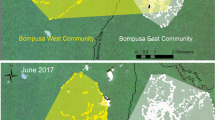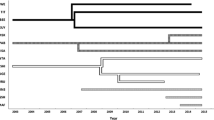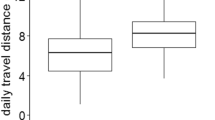Abstract
Socioecological variables influence the rate and nature of encounters between conspecific primate groups. Both social (i.e., type of encounter) and ecological factors (i.e., fruit availability) affect rates and outcomes of intergroup encounters in eastern gorillas. However, the roles of individual factors underlying these events among western lowland gorillas (Gorilla gorilla gorilla) remain relatively understudied. We assessed whether group composition (the number of subordinate males and females in the group) and fruit availability influenced the rate of intergroup encounters in three groups of western lowland gorillas in the Republic of Congo. From April 2014 to October 2018, we monitored focal gorilla groups daily in the Goualougo and Djéké Triangles. To assess the ecological similarity between sites, we compared botanical surveys of trees and herbs across them and found overall herb densities were similar between sites. We observed 294 intergroup encounters over 2797 observation days, with a mean rate of 2.20 ± SD 0.93 encounters/month (range: 1.59–3.94) across groups, and these interactions ranged from tolerant to aggressive. The number of subordinate males in the group correlated negatively with the occurrence of intergroup encounters, and groups were more likely to avoid interaction or react aggressively when they encountered a solitary male than when they encountered another group. Some differences between the groups may be attributed to familiarity with extragroup members and the status of the dominant silverback. We found no relationship between the rate of encounters and fruit availability. Our findings indicate that defense of mates, rather than of food resources, may be the most important driver of between-group competition in western lowland gorillas. These findings, which are similar to those for mountain gorillas, suggest that primate social systems may be more variable than previously anticipated within taxa. Therefore, further longitudinal studies are needed to determine the generality of our findings and assess the direct impacts of intergroup encounters on fitness.






Similar content being viewed by others
References
Bates, D., Maechler, M., Bolker, B., & Walker, S. (2015). Fitting linear mixed-effects models using lme4. Journal of Statistical Software, 67, 1–48. https://doi.org/10.18637/jss.v067.i01.
Bermejo, M. (2004). Home-range use and intergroup encounters in western gorillas (Gorilla g. gorilla) at Lossi forest, North Congo. American Journal of Primatology, 64, 223–232.
Bradley, B., Doran-Sheehy, D., Lukas, D., Boesch, C., & Vigilant, L. (2004). Dispersed male networks in western gorillas. Current Biology, 14, 510–513.
Caillaud, D., Levrero, F., Gatti, S., Menard, N., & Raymond, M. (2008). Influence of male morphology on male mating status and behavior during interunit encounters in western lowland gorillas. American Journal of Physical Anthropology, 135, 379–388.
Caillaud, D., Ndagijimana, F., Giarrusso, A. J., Vecellio, V., & Stoinski, T. S. (2014). Mountain gorilla ranging patterns: Influence of group size and group dynamics. American Journal of Primatology, 76, 730–746.
Cheney, D. (1987). Interactions and relationships between groups. In B. B. Smuts, D. L. Cheney, R. M. Seyfarth, R. W. Wrangham, & T. T. Struhsaker (Eds.), Primate societies (pp. 267–281). Chicago: University of Chicago Press.
Cheney, D. (1992). Intragroup cohesion and intergroup hostility: the relation between grooming distributions and intergroup competition among female primates. Behavioral Ecology, 3, 334–345.
Cooper, M., Aureli, F., & Singh, M. (2004). Between-group encounters among bonnet macaques (Macaca radiata). Behavioral Ecology and Sociobiology, 56, 217–227.
Cowlishaw, G. (1995). Behavioural patterns in baboon group encounters: The role of resource competition and male reproductive strategies. Behaviour, 132, 75–86.
Cristóbal-Azkarate, J., Chavira, R., Boeck, L., Rodríguez-Luna, E., & Veàl, J. J. (2006). Testosterone levels of free-ranging resident mantled howler monkey males in relation to the number and density of solitary males: A test of the challenge hypothesis. Hormones and Behavior, 49, 261–267.
Crofoot, M. C., & Wrangham, R. W. (2010). Intergroup aggression in primates and humans: The case for a unified theory. In Mind the gap (pp. 171–195). Berlin, Heidelberg: Springer.
Doran, D., & McNeilage, A. (1998). Gorilla ecology and behaviour. Evolutionary Anthropology, 6, 120–131.
Doran-Sheehy, D., Greer, D., Mongo, P., & Schwindt, D. (2004). Impact of ecological and social factors on ranging in western gorillas. American Journal of Primatology, 64, 207–222.
Douadi, M., Gatti, S., Levrero, F., Duhamel, G., Bermejo, M., et al (2007). Sex-biased dispersal in western lowland gorillas (Gorilla gorilla gorilla). Molecular Ecology, 16, 2247–2259.
Fashing, P. (2001). Male and female strategies during intergroup encounters in guerezas (Colobus guereza): Evidence for resource defense mediated through males and a comparison with other primates. Behavioral Ecology and Sociobiology, 50, 219–230.
Field, A. (2005). Discovering statistics using SPSS (2nd ed.). London: SAGE.
Forcina, G., Vallet, D., Le Gouar, P. J., Bernardo-Madrid, R., Illera, G., et al (2019). From groups to communities in western lowland gorillas. Proceedings of the Royal Society of London B: Biological Sciences, 286, 1–9.
Garber, P. A., & Kowalewski, M. K. (2011). Collective action and male affiliation in howler monkeys (Alouatta caraya). In Origins of altruism and cooperation (pp. 145–165). Springer, New York, NY.
Gatti, S., Levréro, F., Ménard, N., & Gautier-Hion, A. (2004). Population and group structure of western lowland gorillas (Gorilla gorilla) at Lokoue, Republic of Congo. American Journal of Primatology, 63, 111–123.
Gilardi, K.V., Gillespie, T.R., Leendertz, F.H., Macfie, E.J., Travis, D.A., Whittier, C.A. & Williamson, E.A. (2015). Best Practice Guidelines for Health Monitoring and Disease Control in Great Ape Populations. Gland, Switzerland: IUCN SSC Primate Specialist Group. 56pp.
Goldsmith, M. (1996). Seasonal fluctuation in diet and its effect on the foraging effort of western lowland gorillas (Gorilla g. gorilla) in the Central African Republic. American Journal of Physical Anthropology Supplement, 22, 114.
Goodall, J. (1986). The chimpanzees of Gombe: Patterns of behavior. Cambridge, MA: Belknap Press of Harvard University Press.
Greenway, K. (2015). Threat and display: Reproductive competition in wild male western gorillas (Gorilla gorilla). Dissertation thesis.
Harcourt, A. (1978). Strategies of emigration and transfer by primates, with particular reference to gorillas. Zeitschrift für Tierpsychologie, 48, 401–420.
Harcourt, A., & Stewart, K. (2007). Gorilla society: Conflict, compromise, and cooperation between the sexes. Chicago: University of Chicago Press.
Harcourt, A. H., Stewart, K. S., & Fossey, D. (1976). Male emigration and female transfer in wild mountain gorilla. Nature, 263(5574), 226–227.
Inoue, E., Akomo‐Okoue, E.F., Ando, C., Iwata, Y., Judai, M., Fujita, S., Hongo, S., Nze‐Nkogue, C., Inoue‐Murayama, M., Yamagiwa, J. (2013). Male genetic structure and paternity in western lowland gorillas (Gorilla gorilla gorilla). American Journal of Physical Anthropology, 151, 583–588.
Kitchen, D. M. (2004). Alpha male black howler monkey responses to loud calls: Effect of numeric odds, male companion behaviour and reproductive investment. Animal Behaviour, 67, 125–139.
Koch, F., Signer, J., Kappeler, P. M., & Fichtel, C. (2016). The role of the residence-effect on the outcome of intergroup encounters in Verreaux’s sifakas. Scientific Reports, 6, 1–7.
Levéro, F. (2005). Structure d'une population de gorilles (Gorilla g. gorilla) visitant une clairière forestière: Nature et rôle des rencontres intergroupes dans sa dynamique. Doctoral dissertation, Rennes 1.
Macfie, E. J., & Williamson, E. A. (2010). Best practice guidelines for great ape tourism (pp. 1–87). Gland: IUCN/SSC Primate Specialist Group.
Magliocca, F. (1999). Population and group structure of Western lowland gorillas visiting the Maya North clearing, Odzala National Park, People’s Republic of Congo. Folia Primatologica, 70, 215.
Magliocca, F., & Gautier-Hion, A. (2002). Mineral content as a basis for food selection by western lowland gorillas in a forest clearing. American Journal of Primatology, 57, 67–77.
Magliocca, F., & Gautier-Hion, A. (2004). Intergroup encounters in western lowland gorillas at a forest clearing. Folia Primatologica, 75, 379–382.
Malone, N., Fuentes, A., & White, F. J. (2012). Variation in the social systems of extant hominoids: comparative insight into the social behavior of early hominins. International Journal of Primatology, 33, 1251–1277.
Mirville, M. O., Ridley, A. R., Samedi, J. P. M., Vecellio, V., Ndagijimana, F., Stoinski, T. S., & Grueter, C. C. (2019). Intragroup behavioral changes following intergroup conflict in mountain gorillas (Gorilla beringei beringei). International Journal of Primatology, 1-19.
Mirville, M. O. (2018). The Causes and Consequences of Intergroup Interactions in Mountain Gorillas ( Gorilla beringei beringei). D.Phil. thesis. Crawley, Australia: University of Western Australia.
Mirville, M. O., Ridley, A. R., Samedi, J. P. M., Vecellio, V., Ndagijimana, F., et al (2018a). Low familiarity and similar ‘group strength’ between opponents increase the intensity of intergroup interactions in mountain gorillas (Gorilla beringei beringei). Behavioral Ecology and Sociobiology, 72, 178.
Mirville, M. O., Ridley, A. R., Samedi, J. P. M., Vecellio, V., Ndagijimana, F., et al (2018b). Factors influencing individual participation during intergroup interactions in mountain gorillas. Animal Behaviour, 144, 75–86.
Morgan, D., Strindberg, S., Winston, W., Stephens, C. R., Traub, C., et al (2019). Impacts of selective logging and associated anthropogenic disturbance on intact forest landscapes and apes of northern Congo. Frontiers in Forests and Global Change, 2(28), 1–13.
Morrison, R. E., Groenenberg, M., Breuer, T., Manguette, M. L., & Walsh, P. D. (2019). Hierarchical social modularity in gorillas. Proceedings of the Royal Society of London B: Biological Sciences, 286, 1–7.
Okamoto, K., & Matsumura, S. (2002). Intergroup encounters in wild moor macaques (Macaca maurus). Primates, 43, 119–125.
Parnell, R. (2002a). Group size and structure in western lowland gorillas (Gorilla gorilla gorilla) at Mbeli Bai, Republic of Congo. American Journal of Primatology, 56, 193–206.
Parnell, R. (2002b). The social structure and behaviour of western lowland gorillas (Gorilla gorilla gorilla) at Mbeli Bai, Republic of Congo. Dissertation thesis.
Perry, S. (1996). Intergroup encounters in wild white-faced capuchins (Cebus capucinus). International Journal of Primatology, 17, 309–330.
Pisor, A. C., & Surbeck, M. (2019). The evolution of intergroup tolerance in nonhuman primates and humans. Evolutionary Anthropology: Issues, News, and Reviews, 28, 210-223.
Quinn, G. P., & Keough, M. J. (2002). Experimental designs and data analysis for biologists (1st ed.). Cambridge: Cambridge University Press.
R Core Team (2017). R: A language and environment for statistical computing. Vienna, Austria: R Foundation for Statistical Computing https://www.R-project.org/.
Robbins, M. M. (1996). Male–male interactions in heterosexual and all male wild mountain gorilla groups. Ethology, 102, 942–965.
Robbins, M., & Sawyer, S. (2007). Intergroup encounters in mountain gorillas of Bwindi impenetrable National Park, Uganda. Behaviour, 144, 1497–1519.
Robbins, M. M., Bermejo, M., Cipolletta, C., Magliocca, F., Parnell, R. J., & Stokes, E. (2004). Social structure and life-history patterns in western gorillas (Gorilla gorilla gorilla). American Journal of Primatology, 64, 145–159.
Robbins, M. M., Gray, M., Kagoda, E., & Robbins, A. M. (2009a). Population dynamics of the Bwindi mountain gorillas. Biological Conservation, 142, 2886–2895.
Robbins, A. M., Stoinski, T. S., Fawcett, K. A., & Robbins, M. M. (2009b). Socioecological influences on the dispersal of female mountain gorillas: Evidence of a second folivore paradox. Behavioral Ecology and Sociobiology, 63, 477–489.
Rosenbaum, S., Hirwa, J. P., Silk, J. B., & Stoinski, T. S. (2016a). Relationships between adult male and maturing mountain gorillas persist across developmental stages and social upheaval. Ethology, 122, 134–150.
Rosenbaum, S., Vecellio, V., & Stoinski, T. (2016b). Observations of severe and lethal coalitionary attacks in wild mountain gorillas. Scientific Reports, 6, 1–8.
Scarry, C. J., & Tujague, M. P. (2012). Consequences of lethal intragroup aggression and alpha male replacement on intergroup relations and home range use in tufted capuchin monkeys (Cebus apella nigritus). American Journal of Primatology, 74, 804–810.
Sicotte, P. (1993). Inter-group encounters and female transfer in mountain gorillas: Influence of group composition on male behavior. American Journal of Primatology, 30, 21–36.
Stokes, E. J., Parnell, R. J., & Olejniczak, C. (2003). Female dispersal and reproductive success in wild western lowland gorillas (Gorilla gorilla gorilla). Behavioral Ecology and Sociobiology, 54(4), 329–339.
Sugiura, H., Saito, C., Sato, S., Agetsuma, N., Takahashi, H., et al (2000). Variation in intergroup encounters in two populations of Japanese macaques. International Journal of Primatology, 21, 519–535.
Taylor, A., & Goldsmith, M. (Eds.). (2002). Gorilla biology: A Multidisciplinary Perspective. Volume 34. Cambridge University Press.
Tutin, C. (1996). Ranging and social structure of lowland gorillas in the Lope Reserve, Gabon. In W. C. McGrew, L. F. Marchant, & T. Nishida (Eds.), Great ape societies (pp. 58–70). Cambridge: Cambridge University Press.
van Schaik, C. P. (1989). The ecology of social relationships amongst female primates. In V. Standen & R. Foley (Eds.), Comparative socioecology: The behavioral ecology of humans and other mammals (pp. 195–218). Oxford: Blackwell Scientific.
van Schaik, C. (1996). Social evolution in primates: The role of ecological factors and male behaviour. Proceedings of the British Academy, 88, 9–32.
Walsh, P. D., Breuer, T., Sanz, C., Morgan, D., & Doran-Sheehy, D. (2007). Potential for Ebola transmission between gorilla and chimpanzee social groups. The American Naturalist, 169, 684–689.
Waser, P. (1976). Cercocebus albigena: Site attachment, avoidance, and inter-group spacing. American Society of Naturalists, 110, 911–935.
Watts, D. (1990). Ecology of gorillas and its relation to female transfer in mountain gorillas. International Journal of Primatology, 11, 21–45.
Watts, D. (1994). The influence of male mating tactics on habitat use in mountain gorillas (Gorilla gorilla beringei). Primates, 35, 35–47.
Watts, D. P., & Mitani, J. C. (2001). Boundary patrols and intergroup encounters in wild chimpanzees. Behaviour, 299–327.
Wrangham, R. (1980). An ecological model of female-bonded primate groups. Behavior, 75, 262-300.
Yamagiwa, J. (1987). Intra- and inter-group interactions of an all-male group of Virunga mountain gorillas (Gorilla gorilla beringei). Primates, 28, 1–30.
Yamagiwa, J. (1999). Socioecological factors influencing population structure of gorillas and chimpanzees. Primates, 40, 87–104.
Yi, Y., Fichtel, C., Kim, E., & Choe, J. C. (2020). Impacts of intergroup interactions on intragroup behavioral changes in Javan Gibbons ( Hylobates moloch). International Journal of Primatology, 1–19.
Acknowledgments
We appreciate the continued support of the Ministère de l'Économie Forestière du gouvernement de la République du Congo et du Agence Congolaise de la Faune et des Aires Protégées (ACFAP). The Wildlife Conservation Society's Congo Program and the Nouabalé–Ndoki Foundation are integral partners in this continuing research. Special thanks are due to E. Stokes, M. Gately, J. M. Fay, P. Telfer, P. Elkan, S. Elkan, B. Curran, B. Djoni, P. Ngouembe, D. Dos Santos, T. Breuer, M. Ngangoue, E. Arnhem, and T. Brncic. We are extremely grateful to C. Eyana-Ayina for his guidance and support. This work is possible only through the dedication of the Goualougo and Mondika research and tracking teams. Grateful acknowledgments of funding are due to the Lincoln Park Zoo, Indianapolis Zoo, Houston Zoo, Cincinnati Zoo & Botanical Garden, Columbus Zoological Park, and the Arcus Foundation. We want to thank the reviewers of the International Journal of Primatology whose feedback and suggestions strengthened our manuscript. We would also like to extend a very special thank you to J. Setchell for her careful review of the mansucript and insightful comments.
Author information
Authors and Affiliations
Corresponding author
Additional information
Handling Editor: Cyril Grueter
Rights and permissions
About this article
Cite this article
Cooksey, K., Sanz, C., Ebombi, T.F. et al. Socioecological Factors Influencing Intergroup Encounters in Western Lowland Gorillas (Gorilla gorilla gorilla). Int J Primatol 41, 181–202 (2020). https://doi.org/10.1007/s10764-020-00147-6
Received:
Accepted:
Published:
Issue Date:
DOI: https://doi.org/10.1007/s10764-020-00147-6




